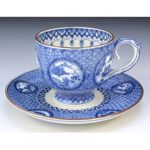Authentic Kiyomizu ware Japanese tea sets (yunomi and kyusu)
Actually, Kyoto is famous for having the area’s historic sites including the temples and shrines.
World Heritage Site of the temples in Kyoto
But the cultural district also has many specialties. One of that is Japanese green tea. A green tea in Kyoto, Uji-cha (宇治茶) has more than 800 years history. The high-class green tea is often used for the tea ceremony.
The classic green tea brought forth a beautiful pottery. That is Kiyomizu-yaki (Kyo-yaki).
Japanese tea sets of Kiyomizu-yaki
!Limited Stocks!
The Tale of Genji
“The Tale of Genji” is the masterpiece literature written by Musaraki-shikibu in the 16th century. The story tells the elegant court life and love romance of Hikaru Genji.
Without cover
With covers
Obisansui (Lanscape in line)
The landscape with the color of indigo (Sometsuke) in a line. Simple but refined pattern.
Without cover
With covers
Shiroinka (White flower stamp)
Shiroinka is one of the traditional methods to make patterns on a pottery. After forming, the craftsmen put a seal on it.
Kikuborishonzui (Chrysanthemum and good omens)
The shape of the pottery looks like a chrysanthemum and have patterns of landscape and lucky symbols. It’s really refined one.
Without cover
With covers
Horiakae-kacho (Red colored flowers and birds)
One of the representative patterns of Kiyomizu-yaki. Polished and graceful.
Kozanji (Chōjū-giga)
Chōjū-giga is an Animal Caricatures. Since Kozanji Temple has stored the picture scroll, people call the pattern also as Kozanji. The scroll is popular in Japan.
Hanagawari (Change of flowers)
The typical pattern of Kyo-yaki. The change of flowers also means the change of climates.
Green leaf
The fresh colors are impressive. It’s like a scene of Arashiyama in April.
Shirogake-soka (White glazed with beautiful flowers)
The white glaze impresses the brightness of the flowers.
Hiwa-unka (Hazy Weather in Spring on yellowish green base)
Coming of Spring takes humidity to the Japanese islands. It is a cultural theme in the country.
Without cover
With covers
Shisaikamon (Purple and gold coloring)
Not bright but luxury.
Hagigasane (Purple of Japanese bush clover)
The color of Hagi (Japanese bush clover) was the noblest in ancient times in Japan.
Kiyomizu ware (Kyo ware)
As the Traditional Crafts designated by Minister of Economy, Trade, and Industry, the formal name of the pottery is “Kyo-yaki/Kiyomizu-yaki”. In ancient times, there were many other potteries in Kyoto and all of them were Kyo-yaki.
Today, it doesn’t matter that you recognize Kiyomizu-yaki and Kyo-yaki are the same things. Kiyomizu (Kyo) ware is the pottery produced in Higashiyama, Yamashina, and Uji area to be exact.
As the famous producing district of the Japanese green tea, the potteries from around the country were on the market in Kyoto from ancient times. But it hadn’t an original pottery.
With the development of the tea culture, the potteries gathered in the city and made the original one in Momoyama Period (1568-1600).
Since the Imperial family and court nobles lived in the central city of Japan, the potteries made the elegant and valuable products for them. It influenced Kutani ware in Ishikawa Prefecture.
The craftsmen of Kiyomizu-yaki/Kyo-yaki concentaite their skill on making the ceramic fit hands with the high-quality materials. From the fact that the pottery doesn’t have predefined earth, glaze, or method just like Arita (Imari) ware and Hagi ware.
So each of the pottery shows the skill and sensitivity of the craftsman.






















